Flux residue CAN be corrosive and conductive particularly if has been burned with subsequent rework. It's more of
a problem in high impedance circuits but you can not make a blanket statement that it is not a problem because
sometimes it is. I've only been doing this for 50 years so I haven't seen it all yet.
G²
That's nice, I'll be sure and tell my fellow techs that, they always look better when they're smiling.
Not sure if its been mentioned earlier but please use a DBT (dim bulb tester) when you do power it up as that can often save parts from getting damaged in the event of (further) faults.
Hi Mooly,
Thanks for your advice. Audio Service did mention using a dim bulb tester, I plan on building, and using, one closer to the time of testing.
I did some multimeter checks on the large capacitors (ELNA 10000uF 56V). Previously thought needed replacing, however once removed from board DMM is telling me the capacitance is within the 10000uF +-20% range. These were manufactured in 1996 so I makes sence to replace, but that's easier said then done.
I am beginning to find that diagnosing these issues represents just a fraction of the challenge. The bulk of it is finding genuine replacement parts

Would like : ELNA 10000uF 63V (as the 56V seem non existent)
Would like : Toshiba 2SD1508
Need : Toshiba 2SA1265N
Need : Toshiba 2SC3182N
Need : Mica shims for the above transistors
That's my shopping list so far
 , and I've tried RS-online, Mouser, Farnell, Switchelectronics, Amazon, Ebay, Aliexpress.
, and I've tried RS-online, Mouser, Farnell, Switchelectronics, Amazon, Ebay, Aliexpress.The latter two might list something but they are obviously fake. Is sourcing electronic parts always this difficult or am I doing something wrong.....do I need a "special" password so I'm taken seriously buy the splliers above

 lol
lolThanks to all who are helping and reading
Kind regards and stay safe
Bass out
PS will report on the actual test and readings on the caps, currently doing above and going through the board
The shorted transistors would be the cause of the fuse blowing.
But there will also be resistors as advised before that will require replacing.
Hi Audio Service,
Hope your doing well.
I have had a closer look at the capacitors, obviously from the below picture you can see that the resin was definitely glue and not weeping out of the capacitor as first thought.
View attachment 896709
I took the following picture to try and show the swollen top on the capacitor (one in the background is the swollen one) but you can't really notice it. (I can definitely feel it, maybe I'm just being a bit over cautious)
View attachment 896710
Ok so, I only have a DMM and not an ESR so one might argue my readings are not conclusive. I carried out the following three tests
1. resistance across the terminals
2. Capacitance reading
3. Charged the capacitor with a 9v battery (for 5minutes) and measured the instantaneous voltage, the voltage after 1 minute connecter to DMM, and then 2minutes.
The following is what I found :
View attachment 896711
Looks like they are fine. What do you think? I must admit I was not expecting such a high resistance as the articles I read stated the ohms should not be in the Mega range. The capacitance is within the 20% tolerance and the voltage readings seem fine. So unless you think otherwise, these are good to stay
I have been inspecting the other components on the board with a magnifying glass and noticed R802 is showing signs of distress:
View attachment 896712
Do you have any idea what this resistor is controlling?
Bass out
I am unable to view the attachments its comes back as contact administrator.
The two ELNA 10000uF 56V capacitors are not of concern right now they will be fine and you can change them in the future if you wish.
The focus needs to be on fixing the Amplifier board as there will be multiple blown components resistors and transistors.
R802 is a 47 ohm resistor and is part of the series regulator circuit for the plus 24 Volt supply.
Due to the age of the Amplifier there will be discolouring on the board caused by heat from the resistor(s) as long as the resistor has not gone high in value there is no reason to change it.
But check the solder joints in that area as they will need reflowing as the solder breaks down over time due to the heat and leads to dry solder joints.
A low component tester can be purchased on line and will include an ESR function just ensure it covers the range of capacitors your looking to test.
This link provides information on ESR meters.
ESR meter - Wikipedia
The two ELNA 10000uF 56V capacitors are not of concern right now they will be fine and you can change them in the future if you wish.
The focus needs to be on fixing the Amplifier board as there will be multiple blown components resistors and transistors.
R802 is a 47 ohm resistor and is part of the series regulator circuit for the plus 24 Volt supply.
Due to the age of the Amplifier there will be discolouring on the board caused by heat from the resistor(s) as long as the resistor has not gone high in value there is no reason to change it.
But check the solder joints in that area as they will need reflowing as the solder breaks down over time due to the heat and leads to dry solder joints.
A low component tester can be purchased on line and will include an ESR function just ensure it covers the range of capacitors your looking to test.
This link provides information on ESR meters.
ESR meter - Wikipedia
Hi Audio Service,
Hope your doing well.
I have had a closer look at the capacitors, obviously from the below picture you can see that the resin was definitely glue and not weeping out of the capacitor as first thought.
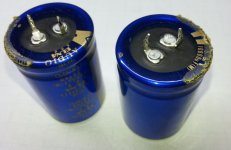
I took the following picture to try and show the swollen top on the capacitor (one in the background is the swollen one) but you can't really notice it. (I can definitely feel it, maybe I'm just being a bit over cautious)
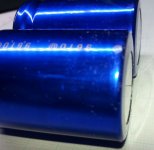
Ok so, I only have a DMM and not an ESR so one might argue my readings are not conclusive. I carried out the following three tests
1. resistance across the terminals
2. Capacitance reading
3. Charged the capacitor with a 9v battery (for 5minutes) and measured the instantaneous voltage, the voltage after 1 minute connecter to DMM, and then 2minutes.
The following is what I found :
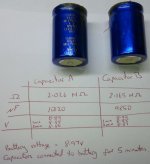
Looks like they are fine. What do you think? I must admit I was not expecting such a high resistance as the articles I read stated the ohms should not be in the Mega range. The capacitance is within the 20% tolerance and the voltage readings seem fine. So unless you think otherwise, these are good to stay
I have been inspecting the other components on the board with a magnifying glass and noticed R802 is showing signs of distress:
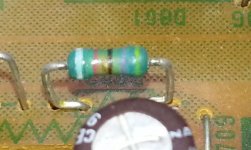
Do you have any idea what this resistor is controlling?
Bass out
lets see if this works




I am unable to view the attachments its comes back as contact administrator.
The two ELNA 10000uF 56V capacitors are not of concern right now they will be fine and you can change them in the future if you wish.
The focus needs to be on fixing the Amplifier board as there will be multiple blown components resistors and transistors.
R802 is a 47 ohm resistor and is part of the series regulator circuit for the plus 24 Volt supply.
Due to the age of the Amplifier there will be discolouring on the board caused by heat from the resistor(s) as long as the resistor has not gone high in value there is no reason to change it.
But check the solder joints in that area as they will need reflowing as the solder breaks down over time due to the heat and leads to dry solder joints.
A low component tester can be purchased on line and will include an ESR function just ensure it covers the range of capacitors your looking to test.
This link provides information on ESR meters.
ESR meter - Wikipedia
Thanks for the quick reply,
I have not removed R802 from the board and when testing it's resistance (on the board) it seems ok, DMM is reading at 46.9 ohms, the solder joints look good, however no issue in reflowing.
I am starting to get concerned regarding being able to fix this amp. Initially I was worrying about the ELNA capacitors, I have come to terms that I can substitute the ELNA caps with Nichicon or Panasonic (like you said IF need be). However, the transistors are impossible to find. I emailed Toshiba, not had a reply from them yet, maybe in the next few days I might get something. I also emails a few auction sellers and questioned if what they were selling was genuine...again no reply

Is there an alternative to 2SA1265N, 2SC3182N, and maybe 2SD1508, I can use? Or would that be like using cooking oil in place of engine oil
Thank you
Donberg have all the transistors your looking for in stock.
Dönberg Electronics - Electronic Components and Equipment - UK (GBP)
Donberg have all the transistors your looking for in stock.
Dönberg Electronics - Electronic Components and Equipment - UK (GBP)
Hi Audio Service,
I did look at Donberg Electronics, as you suggested in your first post to me.
I have a concern, they are selling the transistors as branded by Toshiba. The Toshiba Semicondustors logo is
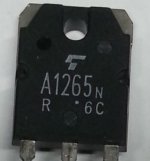
and not this (to the best of my knowledge)
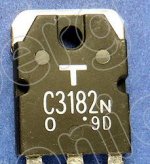
So does this mean that they are selling the same knock offs, I can buy on the auction sites, but at 700-1000% markup ?
Even on Toshibas Semiconductor website the logo is as the first image


I did look at Donberg Electronics, as you suggested in your first post to me.
I have a concern, they are selling the transistors as branded by Toshiba. The Toshiba Semicondustors logo is

and not this (to the best of my knowledge)

So does this mean that they are selling the same knock offs, I can buy on the auction sites, but at 700-1000% markup ?
Even on Toshibas Semiconductor website the logo is as the first image

Donberg has been in business for many years and is a reputable supplier.
The Toshiba devices are obsolete so the only way to source genuine replacements is purchase new old stock or pulled originals.
For example
2SA1265N 2SC3182N Toshiba Power Transistor Pair
https://www.ebay.co.uk/i/121057030925?chn=ps&mkevt=1&mkcid=28
The Toshiba devices are obsolete so the only way to source genuine replacements is purchase new old stock or pulled originals.
For example
2SA1265N 2SC3182N Toshiba Power Transistor Pair
https://www.ebay.co.uk/i/121057030925?chn=ps&mkevt=1&mkcid=28
- Status
- This old topic is closed. If you want to reopen this topic, contact a moderator using the "Report Post" button.
- Home
- Amplifiers
- Solid State
- Marantz PM66 SE keeps blowing fuse